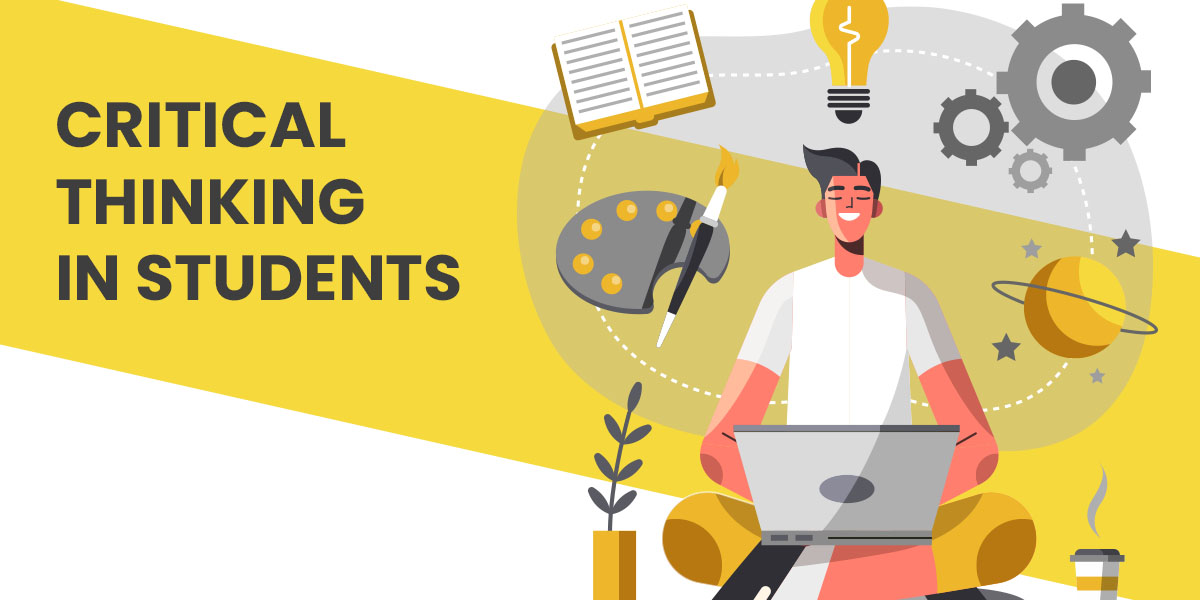Developing creative thinking skills for students in a class has become an indispensable aspect of education. However, teaching critical thinking skills is a challenge for teachers. In order to create a classroom that has motivated learners, and one that is full of fun and excitement, developing creative thinking in learners is vital.
What are critical thinking skills?
- Critical thinking skills for students are those that go far beyond memorization of a concept. Teaching critical thinking skills will allow students to do more than just recite knowledge.
- Critical thinking enables students to join the dots between different concepts, think creatively, and apply the concepts learned in the real world.
- Many people believe that critical thinking skills can only be applied to certain subjects like mathematics, science, etc.
- The fact is that creative thinking skills for students that involve evaluation and knowledge application are not limited to the core subjects of school alone.
- Critical thinking skills can be applied to day-to-day life and tasks as well.
- Critical thinking skills involve deeply analyzing a particular topic or problem based on the given information, putting aside judgements or assumptions.
- With critical thinking skills, students get the ability to think critically about a problem, evaluate it, and solve it.
Key skills for critical thinking
- Problem-solving skills
- Communication skills
- Interpersonal skills
- Observation skills
- Analytical skills
- Self-directional skills
Benefits of critical thinking skills in students
- It helps to improve the decision-making process.
- Students learn the problem-solving approach to handle any complex situation and come up with an effective solution.
- It boosts creativity and generates curiosity.
- It allows children to think outside the box and come up with new creative ideas.
- It encourages open-mindedness towards the views of others.
- It creates a sense of independence amongst students as they can make their own independent decisions and form their own opinions.
These are some of the most effective strategies for developing creative thinking skills in students.
Asking questions
- Questioning students is an essential tool for promoting critical thinking skills in students.
- Instead of asking simple ‘Yes’, ‘No’, or ‘Right’ or ‘Wrong’ questions, open-ended questions allow students to think deeper.
- For example, instead of asking students, “Is it important to learn math?” a better and more thought-provoking question would be, “Why is learning math important?”
- Questions like “How”, “When”, “Why”, and “Who” give students the chance to apply their knowledge and learning and consider all possible outcomes before coming to a conclusion.
- Bloom’s Taxonomy is a great example of teaching critical thinking skills through the questioning technique.
Inspire creativity and imagination
- Teachers should ask students in the classroom to use the information and knowledge and create something new and different.
- Art projects are a great example where young minds can display their imagination and creativity.
- Coming up with new inventions, writing poems, and stories also inspire learners’ creativity and imagination.
- Both creativity and imagination should be at the forefront in the classroom for developing creative thinking in learners.
Freedom to learn differently
- Giving students the freedom to learn is also an effective way of developing critical thinking skills in them.
- After a concept or topic has been introduced in class, teachers must give students the freedom to learn based on their own choice.
- Each student may choose a different learning method, which he/she feels comfortable with.
- Learning differently will help boost critical thinking in the learners.
Project-based learning
- Project-based learning is an indispensable tool to promote the development of critical thinking skills in students.
- Project-based learning motivates the students to understand concepts by solving real-world problems.
Inquiry-based learning
- Inquiry-based learning is not just about asking students what they want to learn.
- It involves generating curiosity and getting the students involved in the learning process.
- One of the first steps for inquiry-based learning is asking students to write down a set of questions to which they want the answers.
Promoting active learning
- The majority of the students that we come across in schools are passive learners.
- They sit back, listen to what the teachers say, and memorize things to write the answers in the examination. In order to facilitate development of critical thinking skills, embracing active learning in the classroom is vital.
- When children actively participate and are involved in the learning process, the logical reasoning powers of students increase.
- For active learning to take place, children must not accept the way things are without truly understanding them.
- For example, most students would know that medicines need to be taken when they are sick. But, what they really need to know is why they should take the medication. What do medicines do? How do the medicines work?
Brainstorming
Brainstorming is an amazing tool for developing critical thinking skills in students. Brainstorming, coupled with visual elements, is capable of bringing any class to life. Brainstorming helps students to find an innovative solution to a problem, build relationships with other students, and appreciate others’ points of view as well. It supports learning in a relaxed and fun environment.
Teachers need to take responsibility to help students learn critical thinking skills so that they can not only perform better in their studies but also meet the challenges of living in a diverse and complex world.


